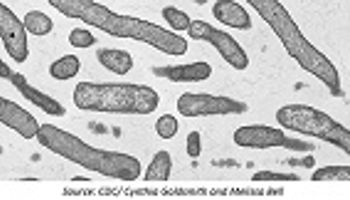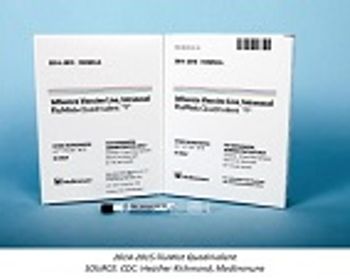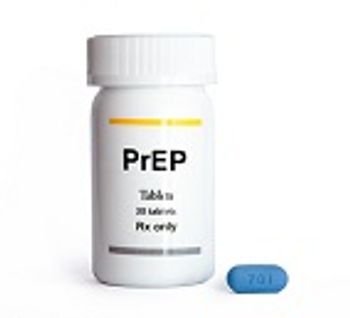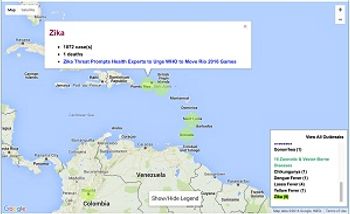
A new case report about the death of a woman from rabies emphasizes the importance of rabies awareness and education among the public.

A new case report about the death of a woman from rabies emphasizes the importance of rabies awareness and education among the public.

During a session at the ASM Microbe 2016 conference on Monday, June 20, 2016, a Centers for Disease Control and Prevention officer presented data on the investigation of the Elizabethkingia anophelis outbreak that started in Wisconsin and spread to two other states.

The Center for Disease Control and Prevention (CDC) Advisory Committee on Immunization Practices (ACIP) has voted against the use of the live attenuated influenza vaccine (LAIV), or “nasal spray,” for the 2016-2017 flu season.

The number of physicians and nurse practitioners aware of HIV pre-exposure prophylaxis (PrEP) and its potential benefits has increased dramatically in the years since it was first introduced to the market.

A therapeutic vaccine for genital herpes has the potential to reduce viral activity as well as decrease the number of days of recurrent herpes, as observed in a phase II clinical trial.

On June 17, the CDC announced that 1% of all blood donations analyzed in the American territory had tested positive for Zika, and that this could be an indication that the outbreak is poised to reach dangerous proportions.

Administration of cholesterol-lowering statins to mice reduced the number of Borrelia burgdorferi bacteria in the rodents and helped to prevent the spread of Lyme disease, a new study has suggested.

Research conducted by the Flint Water Study team at Virginia Tech revealed that DNA marker levels for Legionella in the city’s water supply has decreased since October 2015.

A new study has suggested that Yersinia pestis—the causative agent of plague—likely entered Europe only once, and later spread to China where it has become the source of modern plague outbreaks.

New research suggests that modernized phages therapy may be useful in extending the lifespan of currently available antibiotics and reducing the incidence of antibiotic-resistant infections.

A recent study has estimated the seroprevalence of hepatitis C virus (HCV) infection to be 0.5% in the antenatal population.

With vaccine supplies at alarmingly low levels a potential public health emergency of global proportions may be on the horizon.

In a webinar presented on June 9 by The Department of Health and Human Services (HHS) Working Group on Lyme and Other Tick-borne Diseases, a panel of speakers discussed trends in tick-borne diseases (TBDs) in the United States.

US travelers concerned about contracting cholera during overseas journeys to areas where the disease remains a threat may now have options as they seek to reduce their risk.

A recent review focuses on the biology of human papillomaviruses, their associated burdens, and the clinical data available on HPV vaccine efficacy.

Sequirus recently announced that the US Food and Drug Administration (FDA) has approved Flucelvax Quadrivalent influenza vaccine.

Hepatitis C virus (HCV) cure when using direct-acting antiviral (DAA) agents in human immunodeficiency virus (HIV)-coinfected patients is lower in real-world settings than when patients are enrolled in clinical trials, a new study has found.

A long-held belief regarding the way in which vaccinations work to protect hosts from pathogens may be inaccurate.

Researchers at McGill University in Montreal revealed that the gene editing tool known as CRISPR/Cas9, which had previously been shown to hold some promise in removing HIV-infected cells from the human genome, may in fact be a “double-edged sword.”

This article seeks to review newer ART agents, as well as those in later stages of drug development, for the treatment of HIV-1 infection.

An international team of researchers may have identified a potential animal model for use in the laboratory as part of efforts to better understand the pathogenesis of Middle East respiratory syndrome (MERS) coronavirus and, hopefully, find an effective treatment for it: alpacas.

In an effort to contain the Zika virus, the Centers for Disease Control and Prevention (CDC) is holding a series of teleconferences regarding concerns that were raised during the Zap Zika conference held in early April. The fifth conference in the series discusses Zika epidemiology.

Wet steam processing of fruits has the potential to significantly reduce the incidence of food-borne illness associated with contaminated fresh-cut fruits, a new study has suggested.

A new report from the Centers for Disease Control and Prevention (CDC) suggests that many of the reported outbreaks involving Legionella bacteria since 2000 could have been prevented with better testing protocols and infrastructure management.

Contagion has launched a global Outbreak Monitor that allows users to visualize occurrences of infectious diseases, such as Zika and Yellow Fever, on a local, regional, national and international level.

Public health demands integrity, said Margaret Hamburg, MD, former commissioner of the US Food and Drug Administration (FDA), at the Centers for Disease Control and Prevention’s 65th Annual Epidemic Intelligence Service (EIS) Conference in Atlanta, Georgia.

Incidence of syphilis is on the rise in Europe—particularly among men—according to a report released in May by the European Centre for Disease Prevention and Control (ECDC).

Recent studies on Zika have lead researchers to discover how the virus causes neurological complications, as well as ways in which the body can fight off the infection.

The FDA recently granted Emergency Use Authorization for the Idylla Ebola Virus Triage Test, a diagnostic test which detects the presence of the virus in blood.

Each year, norovirus infection is responsible for an estimated 684 million episodes of diarrhea and 212,000 deaths worldwide, and results in approximately $4.2 billion in healthcare costs and $60.3 billion in societal costs, a new report has highlighted.